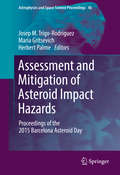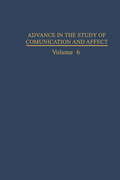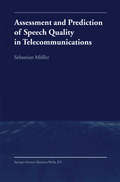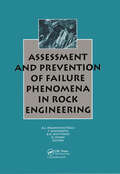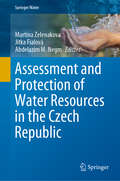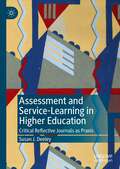- Table View
- List View
Assessment and Learning (PDF)
by John GardnerAssessment and Learning places learning at the centre of our concerns and explicitly underscores the importance of assessment in that learning. This new edition provides a comprehensive overview of assessment that is used to support learning, practice-based theory on assessment for learning, and formative assessment to support individual development and motivate learners. With a strong list of existing and new contributors, this second edition has been updated to include the latest work on assessment. Readers will find research-informed insights from a wide variety of international contexts. It features: - New chapters on e-assessment, the learner's perspective on assessment and learning and the influence of assessment on how we value learning - Teacher-friendly assessment topics - Practical examples and chapter summaries throughout This book is useful to teacher educators and researchers on postgraduate courses in education, teaching, learning and assessment. John Gardner is a professor of education at Queens University Belfast, and President of the British Educational Research Association.
Assessment and Learning (PDF)
by John R. GardnerThis new and unique text is a major source of practice-based theory on assessment for learning, a formative assessment approach to support individual development and motivate learners. Key areas covered in the book include the practice of assessment for learning in the classroom and its power to enhance, developing and maintaining motivation for learning, drawing on the key messages from research, the role of assessment for learning in teachers, assessment and theories of learning, using up-to-date research to consider the reliability and validity of assessment and to debunk some of the myths about the reliability of assessments external to the classroom. Assessment policies across the four countries of the UK and selected European countries, with a commentary on the assessment context in the US. The book is a hugely important output from the internationally known Assessment Reform Group (ARG), which is influential in the field of assessment and education policy and practice in the UK, with related developments as far afield as Australia, Hong Kong, the US and Canada. The group carries out research in order to reach policy-makers in government, and also works closely with teachers and local authority staff. Assessment and Learning will prove a very valuable resource for a wide variety of people involved in teaching, learning and assessment whether as practitioners, researchers or policy-makers.
Assessment and Management of Emotional and Psychosocial Reactions to Brain Damage and Aphasia
by Peter WahrborgAims to provide an accessible and practical guide to the assessment, differentiation and clinical management of the emotional and psychosocial problems of aphasic and non-aphasic brain damaged individuals and their families. Current clinical approaches are also considered.
Assessment and Management of Environmental Risks: Cost-efficient Methods and Applications (NATO Science Series: IV: #4)
by JosePalma-Oliveira IgorLinkovManaging environmental contamination requires decision makers to weigh eXlstmg risks against the potential effects of implementing environmental policies - considering both the benefits and disruptions that may result from different actions. The NATO Advanced Research Workshop in Lisbon was an important step in the development and application of cost efficient methods of risk assessment especiaIly within the constraints of a budget. The goal of the workshop was to evaluate the potential for risk assessment to serve as a unified and unifying technique in addressing a wide range of environmental problems. Papers presented in this book discuss issues ranging from specific and local studies (specific site, ecosystem, pollutant) to global decision and management frameworks (watersheds, regions, integration of multiple poIlutants and stressors); they develop a range of approaches starting from specific methods to widely applied public policies (Figure 1). The papers show that the use of risk assessment can provide the scientific basis for environmentaIly sound and cost-efficient policies, strategies, and solutions to our environmental chaIlenges. The organization of the Proceedings reflects sessions and discussions during the workshop. The papers in the introductory Chapter summarize the positions of Drs. Glenn Suter (EPA) and Jim Wilson (Resources for the Future) regarding whether the use of often-expensive risk assessments in developing countries can be justified, given evolving regulatory institutions and limited resources.
Assessment and Management of Hepatobiliary Disease
by Lajos Okolicsányi, Géza Csomós and Gaetano CrepaldiAssessment and Management of Plant Invasions (Springer Series on Environmental Management)
by James O. Luken John W. ThieretBiological invasion of native plant communities is a high-priority problem in the field of environmental management. Resource managers, biologists, and all those involved in plant communities must consider ecological interactions when assessing both the effects of plant invasion and the long-term effects of management. Sections of the book cover human perceptions of invading plants, assessment of ecological interactions, direct management, and regulation and advocacy. It also includes an appendix with descriptive data for many of the worst weeds.
Assessment and Mitigation of Asteroid Impact Hazards: Proceedings of the 2015 Barcelona Asteroid Day (Astrophysics and Space Science Proceedings #46)
by Josep M. Trigo-Rodríguez Maria Gritsevich Herbert PalmeThis volume is a compilation of the research presented at the International Asteroid Day workshop which was celebrated at Barcelona on June 30th, 2015. The proceedings discuss the beginning of a new era in the study and exploration of the solar system’s minor bodies. International Asteroid Day commemorates the Tunguska event of June 30th, 1908. The workshop’s goal was to promote the importance of dealing proactively with impact hazards from space. Multidisciplinary experts contributed to this discussion by describing the nature of comets and asteroids along with their offspring, meteoroids. New missions to return material samples of asteroids back to Earth such as Osiris-REx and Hayabusa 2, as well as projects like AIM and DART which will test impact deflection techniques for Potentially Hazardous Asteroids encounters were also covered. The proceedings include both an outreach level to popularize impact hazards and a scientific character which covers the latest knowledge on these topics, as well as offering proposals of promising new techniques that will help gain new insights of the properties of these challenging bodies by studying meteoroids and meteorites. Asteroids, comets, meteoroids and meteorites are introduced with descriptions of their nature, origin, and solar system pathways.
Assessment and Modification of Emotional Behavior: (pdf) (Advances in the Study of Communication and Affect #6)
by Kirk R. Blankstein Patricia Pliner and Janet PolivyAssessment and Multimodal Management of Pain: An Integrative Approach
by Maureen Cooney Ann Quinlan-ColwellLearn best practices and evidence-based guidelines for assessing and managing pain! Assessment and Multimodal Management of Pain: An Integrative Approach describes how to provide effective management of pain through the use of multiple medications and techniques, including both pharmacologic and non-pharmacologic treatment regimens. A holistic approach provides an in-depth understanding of pain and includes practical assessment tools along with coverage of opioid and non-opioid analgesics, interventional and herbal approaches to pain, and much more. Written by experts Maureen F. Cooney and Ann Quinlan-Colwell, this reference is a complete, step-by-step guide to contemporary pain assessment and management. - Evidence-based, practical guidance helps students learn to plan and implement pain management, and aligns with current guidelines and best practices. - Comprehensive information on the pharmacologic management of pain includes nonopioid analgesics, opioid analgesics, and co-analgesics, including dose titration, routes of administration, and prevention of side effects. - UNIQUE! Multimodal approach for pain management is explored throughout the book, as it affects assessment, the physiologic experience, and the culturally determined expression, acknowledgement, and management of pain. - UNIQUE! Holistic, integrative approach includes thorough coverage of pain management with non-pharmacologic methods. - Clinical scenarios are cited to illustrate key points. - Equivalent analgesic action for common pain medications provides readers with useful guidance relating to medication selection. - Pain-rating scales in over 20 languages are included in the appendix for improved patient/clinician communication and accurate pain assessment. - UNIQUE! Authors Maureen F. Cooney and Ann Quinlan-Colwell are two of the foremost authorities in multimodal pain assessment and management. - Sample forms, guidelines, protocols, and other hands-on tools are included, and may be reproduced for use in the classroom or clinical setting.
Assessment and Obligatory Treatment of Violent and Sexually Violent Offenders: Integrating Research and Practice (Advances in Preventing and Treating Violence and Aggression)
by Emma J. Palmer Ruud H. J. Hornsveld Floris W. Kraaimaat Luk A. C. L. GijsThis book examines the assessment and obligatory treatment programs for violent and sexually violent offenders – primarily adolescents and adults – diagnosed with cluster B personality disorder or a conduct disorder. It describes concepts, theories, and legal aspects as well as the psychological and neurobiological characteristics of violent and sexually violent offenders and forensic psychiatric patients. Chapters review treatment programs and provide guidelines for gathering additional information and formulating functional analyses to establish individual treatment plans. In addition, chapters offer treatment modules for violent offenders and sexually violent offenders and address specific problems that may be encountered in practice and how to overcome these problems. The book concludes with the editors’ recommendations for future research in offender assessment and rehabilitation.Topics featured in this book include:Heuristic models of aggressive and sexually aggressive behavior.The use of self-reporting questionnaires in offender populations.Reliable assessment instruments.The effectiveness of existing rehabilitation programs. Cognitive-behavioral treatment modules for violent and sexually violent offenders.Self-regulation and self-management skills to be used in rehabilitation programs.Facilitating treatment integrity in penitentiary and forensic psychiatric institutions.Assessment and Obligatory Treatment of Violent and Sexually Violent Offenders is an essential resource for researchers, clinicians/therapists, and upper-level undergraduate and graduate students in forensic psychology, public health, criminology/criminal justice, and behavioral therapy and rehabilitation.
Assessment and Outcomes in the Arts Therapies: A Person-Centred Approach
by Claire Molyneux Laura Fogg-Rogers Mariana Torkington Suzanne C. Purdy Robin Barnaby Abigail Raymond Margaret-Mary Mulqueen Marion Gordon-Flower Sylvia Leão Alison TalmageThere is increasing pressure on therapists to provide details of structured assessments and to report therapy outcomes. This edited volume provides a series of case studies, with varied client groups, giving arts therapists an accessible introduction to assessment and outcome measures that can be easily incorporated into their regular practice.
Assessment and Prediction of Speech Quality in Telecommunications
by Sebastian MöllerThe quality of a telecommunication voice service is largely inftuenced by the quality of the transmission system. Nevertheless, the analysis, synthesis and prediction of quality should take into account its multidimensional aspects. Quality can be regarded as a point where the perceived characteristics and the desired or expected ones meet. A schematic is presented which classifies different entities which contribute to the quality of a service, taking into account conversational, user as weIl as service related contributions. Starting from this concept, perceptively relevant constituents of speech communication quality are identified. The perceptive factors result from ele ments of the transmission configuration. A simulation model is developed and implemented which allows the most relevant parameters of traditional trans mission configurations to be manipulated, in real time and for the conversation situation. Inputs into the simulation are instrumentally measurable quality elements commonly used in transmission planning of telephone networks. A reduced set of these quality elements forms a basis for models which aim at predicting mouth-to-ear quality as it would be perceived by a user of the sys tem. These models are an important tool for the planner of telecommunication networks, as they allow the expected quality to be estimated in advance, even before the network has been set up. Two well-known models (the SUBMOD and the E-model) are analyzed in more detail, with an emphasis on the psy choacoustic and psychophysical backgrounds.
Assessment and Prevention of Failure Phenomena in Rock Engineering
by O. Aydan A. G. Pasamehmetoglu T. Kawamoto B. N. WhittakerFirst published in 1993. This volume is a collection of papers addressing the issue of the failure of rock engineering structures. This phenomenon occurs in different forms depending on the geometry of structure, material properties of intact rock, structure of rock mass, environmental conditions and initial state of stress.
Assessment and Programming for Young Children with Low-Incidence Handicaps
by Julia H. Clark Cecil R. ReynoldsThe public schools have taken on increasing responsibility over the last decade for providing in-school educational services to chil dren with low-incidence handicaps, children who, not very many years ago, would have been relegated to custodial care or limited to care only in the home. With the increasing responsibility for educating these children has come recognition that few of us have the requisite knowledge or skills to deliver high-quality services to these chil dren. University programs are providing more staff, but the existing staff must also be trained. We have been involved for several years, with the special education branch of the Nebraska Department of Edu cation in the provision of in-service training in the early identifi cation and assessment of handicapping conditions, when we realized an even greater need for training regular classroom teachers, administra tors, and psychologists in addition to early childhood special educa tion personnel about the nature of low-incidence handicaps and how they might be dealt with in the public school setting. Knowing the enormity and the expense of such an undertaking, we tenuously ap proached the State Department. They too were cognizant of this need and welcomed our ideas. Jan Thelen and her capable staff then took to coordinating the planning with us and the Nebraska Department of Education provided the fundings.
Assessment and Protection of Water Resources in the Czech Republic (Springer Water)
by Martina Zelenakova Jitka Fialová Abdelazim M. NegmThis book gathers technical and scientific contributions from leading researchers, academics, and lecturers, focusing on water management, water pollution and water structures in the Czech Republic. It discusses a variety of water resources management issues, from stormwater management in urban areas, water quantity, hydraulics structures and hydrodynamic modeling, to flood protection, presenting state-of-the-art developments for addressing a range of problems. Edited and authored by pioneers in the field who have been at the cutting edge of water management development in the Czech Republic, this book is of interest to environmental professionals, including scientists and policymakers both in the Czech Republic and around the globe.
Assessment and Remediation of Contaminated Sediments (Nato Science Series: IV: #73)
by Danny Reible Tomas LanczosIn this text, drawn from presentations and discussion at a May 2005 NATO Advanced Research Workshop, current approaches to the assessment and remediation of contaminated sediments are discussed with emphasis on in-situ management. The text addresses physical, chemical and biological approaches for the assessment and remediation of sediments. The development of regulatory and strategic approaches is discussed with emphasis on the potential for biological remediation in the management of contaminated sediments.
Assessment and Remediation of Petroleum Contaminated Sites
by G. Mattney ColeFederal regulations have required thousands of underground storage tanks (USTs) to be dug up and removed or replaced. The contamination of soil and ground water from leaking USTs has become widespread and has produced an overwhelming number of sites that require remediation. Assessment and Remediation of Petroleum Contaminated Sites presents the broad scope of the remedial process from initial site assessment to closure in an integrated, understandable format. The book guides you effortlessly through regulatory requirements, site assessments and sampling, and remediation methods. RCRA and CERCLA federal regulations are addressed. The chemistry and toxicology of petroleum hydrocarbons in the remediation process are explained, and factors affecting soil remediation are discussed. Environmental assessments, site characterizations, remediation planning, and remediation methods are all covered in detail. The book is an essential guide for environmental consultants, regulatory agency personnel, engineers, and environmental attorneys.
Assessment and Remediation of Petroleum Contaminated Sites
by G. Mattney ColeFederal regulations have required thousands of underground storage tanks (USTs) to be dug up and removed or replaced. The contamination of soil and ground water from leaking USTs has become widespread and has produced an overwhelming number of sites that require remediation. Assessment and Remediation of Petroleum Contaminated Sites presents the broad scope of the remedial process from initial site assessment to closure in an integrated, understandable format. The book guides you effortlessly through regulatory requirements, site assessments and sampling, and remediation methods. RCRA and CERCLA federal regulations are addressed. The chemistry and toxicology of petroleum hydrocarbons in the remediation process are explained, and factors affecting soil remediation are discussed. Environmental assessments, site characterizations, remediation planning, and remediation methods are all covered in detail. The book is an essential guide for environmental consultants, regulatory agency personnel, engineers, and environmental attorneys.
Assessment and Service-Learning in Higher Education: Critical Reflective Journals as Praxis
by Susan J. DeeleyThis book examines service-learning as a critical pedagogy and explores the benefit of creating a reflective journal. It can be a form of assessment for the students' service experiences connected to academic theory through their critical reflection and it can also be a form of critical action based on critical thought.
Assessment and Simulation Tools for Sustainable Energy Systems: Theory and Applications (Green Energy and Technology #129)
by Fausto CavallaroIn recent years, the concept of energy has been revised and a new model based on the principle of sustainability has become more and more pervasive. The appraisal of energy technologies and projects is complex and uncertain as the related decision making has to encompass environmental, technical, economic and social factors and information sources. The scientific procedure of assessment has a vital role as it can supply the right tools to evaluate the actual situation and make realistic forecasts of the effects and outcomes of any actions undertaken. Assessment and Simulation Tools for Sustainable Energy Systems offers reviews of the main assessment and simulation methods used for effective energy assessment. Divided across three sections, Assessment and Simulation Tools for Sustainable Energy Systems develops the reader’s ability to select suitable tools to support decision making and implementation of sustainable energy projects. The first is dedicated to the analysis of theoretical foundations and applications of multi-criteria decision making. This is followed by chapters concentrating on the theory and practice of fuzzy inference, neural nets and algorithms genetics. Finally, simulation methods such as Monte Carlo analysis, mathematical programming and others are detailed. This comprehensive illustration of these tools and their application makes Assessment and Simulation Tools for Sustainable Energy Systems a key guide for researchers, scientists, managers, politicians and industry professionals developing the field of sustainable energy systems. It may also prompt further advancements in soft computing and simulation issues for students and researchers.
Assessment and Staging of Care for People with Dementia: The IDEAL Schedule and its User Manual
by Norman Sartorius Maya Semrau Alistair Burns Gabriela Stoppe Philippe Robert Antonio Lobo Marcel Olde Rikkert Mirjam SchepensAssessment and Staging of Care for Dementia: The IDEAL schedule and its user manual is a unique resource containing a global clinical staging schedule for dementia alongside essential, practical information on how to use it. The International Schedule for the Integrated Assessment and Staging of Care for Dementia (IDEAL) schedule assesses a patient's capacity to function in seven domains. These domains are 'activities of daily living', 'physical health', 'cognitive functioning', 'behavioural and psychological symptoms', 'social support', 'informal care', and 'formal professional care'. Each domain has a set of anchor points to assist with rating the different dimensions appropriately along with critical information on how to calculate the total sum score on the IDEAL schedule. In addition to the IDEAL schedule itself, this resource includes a glossary of key terms and guidance on recommended priorities for interventions for different symptoms and severity patterns. Global examples of how to apply the schedule based on different levels of resources and experience are also presented along with relatable case studies mapped directly to the schedule. Created by the International Dementia Alliance, this innovative tool and user manual is suitable for health care professionals with experience in the diagnosis and treatment of people with dementia around the world, as well as any of those involved in dementia care.
Assessment and Staging of Care for People with Dementia: The IDEAL Schedule and its User Manual
by Maya Semrau Alistair Burns Antonio Lobo Marcel Olde Rikkert Philippe Robert Mirjam Schepens Gabriela Stoppe Norman SartoriusAssessment and Staging of Care for Dementia: The IDEAL schedule and its user manual is a unique resource containing a global clinical staging schedule for dementia alongside essential, practical information on how to use it. The International Schedule for the Integrated Assessment and Staging of Care for Dementia (IDEAL) schedule assesses a patient's capacity to function in seven domains. These domains are 'activities of daily living', 'physical health', 'cognitive functioning', 'behavioural and psychological symptoms', 'social support', 'informal care', and 'formal professional care'. Each domain has a set of anchor points to assist with rating the different dimensions appropriately along with critical information on how to calculate the total sum score on the IDEAL schedule. In addition to the IDEAL schedule itself, this resource includes a glossary of key terms and guidance on recommended priorities for interventions for different symptoms and severity patterns. Global examples of how to apply the schedule based on different levels of resources and experience are also presented along with relatable case studies mapped directly to the schedule. Created by the International Dementia Alliance, this innovative tool and user manual is suitable for health care professionals with experience in the diagnosis and treatment of people with dementia around the world, as well as any of those involved in dementia care.
Assessment and Teaching of 21st Century Skills: Research and Applications (Educational Assessment in an Information Age)
by Esther Care Patrick Griffin Mark WilsonThis book provides a detailed description of research and application outcomes from the Assessment and Teaching of 21st Century Skills project, which explored a framework for understanding the nature of these skills. The major element of this new volume is the presentation of research information from the global assessment of two 21st century skills that are amenable to teaching and learning: collaborative problem solving, and learning in digital networks. The outcomes presented include evidence to support the validity of assessment of 21st century skills and descriptions of consequent pedagogical approaches which can be used both to teach the skills and to use them to enhance key learning goals in secondary education systems. The sections of the volume are connected through a focus on the degree to which innovative assessment tasks measure the constructs of interest. This focus is informed by conceptual and methodological issues associated with affordances of 21st century computer-based assessment. How understanding of the nature of the skills, as derived from these assessments, can guide approaches to the integration of 21st century skills in the classroom, is informed by initiatives adopted by participating countries. The guiding questions in this volume are: "Do the assessment tasks measure the constructs?" and "What are the implications for assessment and teaching in the classroom?" It is the third volume of papers from this project published by Springer.
Assessment and Teaching of 21st Century Skills: Methods and Approach (Educational Assessment in an Information Age)
by Patrick Griffin Esther CareThis second volume of papers from the ATC21STM project deals with the development of an assessment and teaching system of 21st century skills. Readers are guided through a detailed description of the methods used in this process. The first volume was published by Springer in 2012 (Griffin, P., McGaw, B. & Care, E., Eds., Assessment and Teaching of 21st Century Skills, Dordrecht: Springer). The major elements of this new volume are the identification and description of two 21st century skills that are amenable to teaching and learning: collaborative problem solving, and learning in digital networks. Features of the skills that need to be mirrored in their assessment are identified so that they can be reflected in assessment tasks. The tasks are formulated so that reporting of student performance can guide implementation in the classroom for use in teaching and learning. How simple tasks can act as platforms for development of 21st century skills is demonstrated, with the concurrent technical infrastructure required for its support. How countries with different languages and cultures participated and contributed to the development process is described. The psychometric qualities of the online tasks developed are reported, in the context of the robustness of the automated scoring processes. Finally, technical and educational issues to be resolved in global projects of this nature are outlined.
Assessment and Teaching of 21st Century Skills (Educational Assessment in an Information Age)
by Patrick Griffin, Barry McGaw and Esther CareRapid—and seemingly accelerating—changes in the economies of developed nations are having a proportional effect on the skill sets required of workers in many new jobs. Work environments are often technology-heavy, while problems are frequently ill-defined and tackled by multidisciplinary teams. This book contains insights based on research conducted as part of a major international project supported by Cisco, Intel and Microsoft. It faces these new working environments head-on, delineating new ways of thinking about ‘21st-century’ skills and including operational definitions of those skills. The authors focus too on fresh approaches to educational assessment, and present methodological and technological solutions to the barriers that hinder ICT-based assessments of these skills, whether in large-scale surveys or classrooms. Equally committed to defining its terms and providing practical solutions, and including international perspectives and comparative evaluations of assessment methodology and policy, this volume tackles an issue at the top of most educationalists’ agendas.






